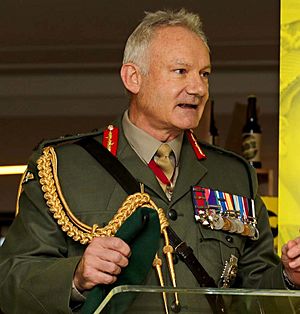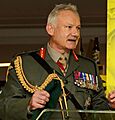Lord High Steward facts for kids
Quick facts for kids Lord High Steward of England |
|
|---|---|
|
Sir Gordon Messenger acted as Lord High Steward of England at the Coronation of Charles III and Camilla.
|
|
| Appointer | The Monarch |
| Term length | At His Majesty's Pleasure |
| Formation | 1154 |
| First holder | The 2nd Earl of Leicester |
| Final holder | General Sir Gordon Messenger |
The Lord High Steward is a very old and important job in England. It's considered the highest of the Great Officers of State, even ranking above the Lord Chancellor.
Today, this role is mostly for special events. It has been empty for a long time, since 1421, and is only filled when there's a coronation of a new king or queen.
During a coronation, the Lord High Steward has the special job of carrying St Edward's Crown. This is a very important part of the ceremony.
In the past, the Lord High Steward also had the unique power to lead special trials for nobles. This kind of trial hasn't happened since 1806, and the law allowing nobles to be tried by other nobles ended in 1948.
Contents
History of the Lord High Steward
From Honorary to Powerful Role
When the job first started, it was mainly an honorary title, meaning it was given as a sign of respect. But over time, it became much more important. The person holding this position became one of the most powerful people in the kingdom.
From the late 1100s, the job was usually held by the Earl of Leicester. This meant it was passed down through that family.
The Office Becomes Ceremonial
In 1399, when Henry IV became king, he gave the job to his second son, Thomas of Lancaster, Duke of Clarence. Thomas held the role until he passed away in 1421. After his death, the job was generally left vacant.
This is why the Lord High Steward is now mostly a ceremonial role, brought back only for very special occasions like coronations.
Similar Roles in Other Countries
Other parts of the United Kingdom also have similar important roles. In Scotland, there's the Great Steward of Scotland. This job is always held by the person who will inherit the throne, known as the Duke of Rothesay in Scotland.
In Ireland, there was the Lord High Steward of Ireland. This role was held by the Earls of Shrewsbury, who also had the title of Earls of Waterford.
Lord High Stewards of England: Key Figures (1154–1421)
This section highlights some of the important people who held the title of Lord High Steward before it became mostly ceremonial.
- 1154–1168: Robert de Beaumont, 2nd Earl of Leicester was the first recorded Lord High Steward.
- 1168–1204: His son and grandson, both named Robert de Beaumont, continued to hold the title, showing how it stayed within the family.
- 1206–1218: Simon de Montfort, 5th Earl of Leicester, who was related to the Beaumonts, took over the role.
- 1239–1265: Another Simon de Montfort, 6th Earl of Leicester, became very powerful. He was almost like a ruler of England for a time.
- 1267–1274: Edward I of England, who later became king, held the position for a short period.
- 1274–1361: The role then passed through the family of King Henry III, including his son Edmund Crouchback and his descendants, the Earls of Lancaster.
- 1362–1399: John of Gaunt, 1st Duke of Lancaster, a son of King Edward III, held the title. He was a very influential figure.
- 1399: His son, Henry Bolingbroke, who became king, briefly held the title.
- 1399–1421: Finally, Thomas of Lancaster, 1st Duke of Clarence, King Henry IV's second son, was the last person to hold the job for a long time before it became mostly ceremonial.
Lord High Stewards of England: Since 1422
Since 1422, the Lord High Steward has mainly been appointed for special events, especially coronations.
Coronations: Carrying the Crown
The Lord High Steward's main duty at a coronation is to carry St Edward's Crown. This is a very important part of the ceremony where a new monarch is crowned. Here are some of the people who have held this role for coronations:
Images for kids



